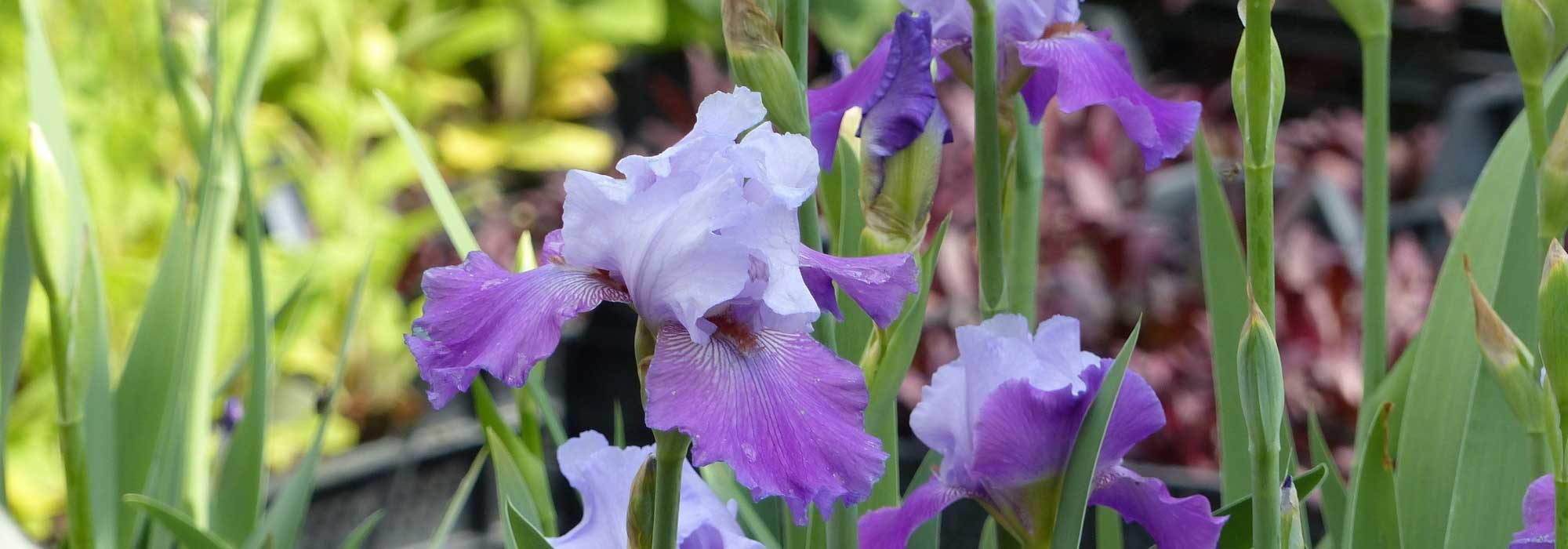
Garden iris, bearded iris: planting, care
Contents
Garden iris in a nutshell
- Bearded iris, or garden iris, inspired Van Gogh and Monet!
- It displays very characteristic flowers highlighted by a contrasting beard
- Of all irises, it offers the widest palette of colours, solid or multicoloured, ranging endlessly from pure blue or white to near-black purple!
- It is a sun-loving plant for dry soils and is hardy
- It is equally at home in beds, borders, banks and rather dry rockeries
A word from our expert
Iris germanica, better known as garden iris, is by far the most famous and most widely cultivated of irises, well ahead of its cousins the marsh irises or Siberian irises. Immortalised by painters Van Gogh and Monet, the garden iris flower has endured through centuries without ever losing its splendour.
From April to June, it offers a spectacular and unforgettable flowering. Its deliciously crumpled flowers, sometimes mysteriously charming, often multicoloured, speckled or flecked, are characterised by a silky beard. Their colours range endlessly from pastel to deeper tones, spanning pure white to deep, almost black violet.
Iris germanica blue, Iris germanica yellow, Iris germanica ‘Florentina’, Iris germanica white or Iris germanica blue-black, their beauty is such that garden irises are always much appreciated in spring in borders and rock gardens as well as in romantic garden, classic borders or contemporary settings.
Among its thousands of cultivars, there are even perpetual Iris germanica and dwarf irises or “Lilliput”!
Discover what to plant with garden irises and fall for our unique collection of brilliant varieties, often exclusive, essential for creating pretty spring displays!
Description and botany
Botanical data
- Latin name Iris germanica
- Family Iridaceae
- Common name garden iris, German iris
- Flowering April to June
- Height 0.20 to 1 m
- Exposure Sun
- Soil type all, well-drained
- Hardiness -15°C to -20°C depending on variety
This genus includes almost 300 species split between bearded and non-bearded rhizomatous irises and bulbous irises. Garden iris belongs to the group of bearded irises. It is the species most commonly planted in gardens and is available in an endless number of cultivars and almost every colour.
Bearded hybrids make up the largest cultivated group. There are more than a thousand varieties.
Garden irises are divided into three subgroups according to flowering period (April to June) and height; from dwarf or Lilliput (0.20 to 0.40 m) to intermediate (0.40 to 0.65 m) and up to tall bearded irises easily exceeding one metre!
Garden iris develops from thick, flattened rootstocks that creep across soil surface. It forms an upright clump of deciduous leaves, sometimes evergreen (unlike other iris species), which will spread fairly quickly, often well beyond allotted space. It enjoys a long life, theoretically multiplying without limit, producing new lateral rosettes each year.
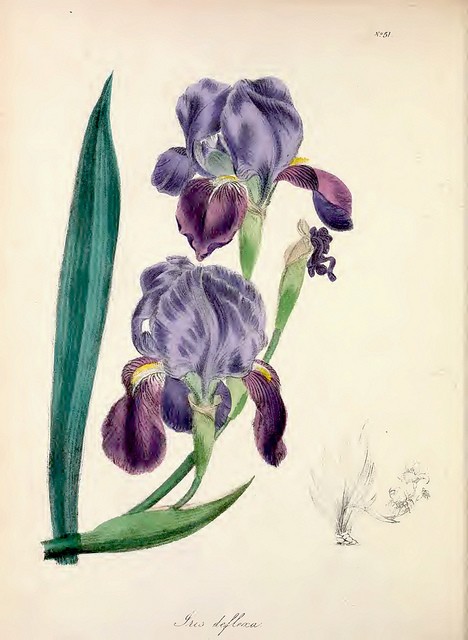
Iris germanica – botanical illustration
These shallow, half-buried rootstocks produce fans of long, broad sword-shaped leaves 30 to 40 cm long. Pointed and glaucous green, they are crossed by many parallel veins.
Each rootstock produces a rigid flowering stem, single or slightly ramified, bearing 5 to 9 flower buds. From April to June, with occasional reblooming late summer depending on variety, flowers open from the top, held above the sharp, sword-like leaves.
On these thick clumps of lanceolate leaves, green often tinged with blue, they stand tall to reveal their distinctive pattern that inspired Van Gogh and Monet. Some call them “the poor man’s orchid.”
As in other Iris species, flowers are made of three large upright petals over three drooping sepals, often frilly, around a “beard”. They differ from other iris flowers by bearing small hairs, often in contrasting colours, at the base of the sepals, a characteristic that gives them the name bearded iris. This beard enhances the flower’s personality.
These large, delicately crumpled flowers measuring 4 to 16 cm in diameter come in a bright palette of colours — solid, boldly bicolour or graduated. Colours are beautifully distributed across these elegant blooms.
Alongside classic violet-blue, they embrace almost every hue, from subtle to unusual, even extravagant, ranging from smoked copper and wild strawberry pink to coppery red, yellow or pure white.
These corollas, with velvety texture and beautifully undulating form, are subtly striate, sometimes simply speckled, edged or fully veined with darker stripes or margins.
Iris flowers are greatly prized for making bouquets.
Flowering is ephemeral, lasting only a few weeks. Some perpetual bearded irises can flower three times a year, especially late season.
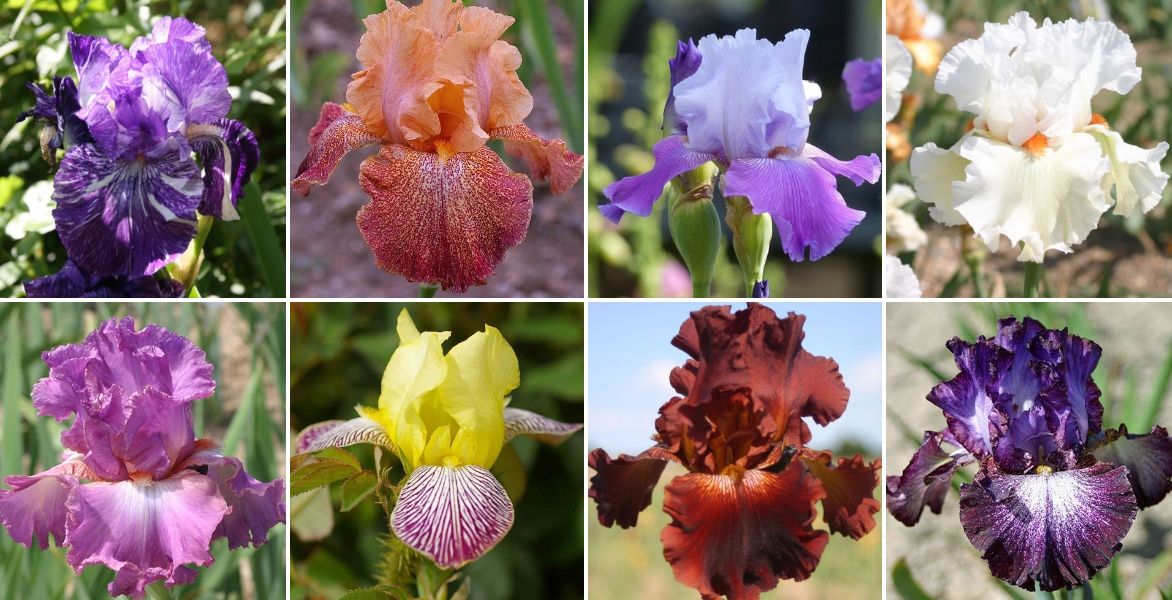
Bearded irises present an incredible diversity of colours!delicate orange blossom scent.
Very hardy to -15°C to -20°C, the garden iris thrives in full sun in rather dry, well-drained soil with slight fertility. It tolerates cold and summer drought, disliking only overly wet soil.
It is always much sought after to flower beds, borders or avenues, and mixed borders where it brings an elegant, spectacular touch of colour.
[caption id="attachment_57075" align="aligncenter" width="1172"]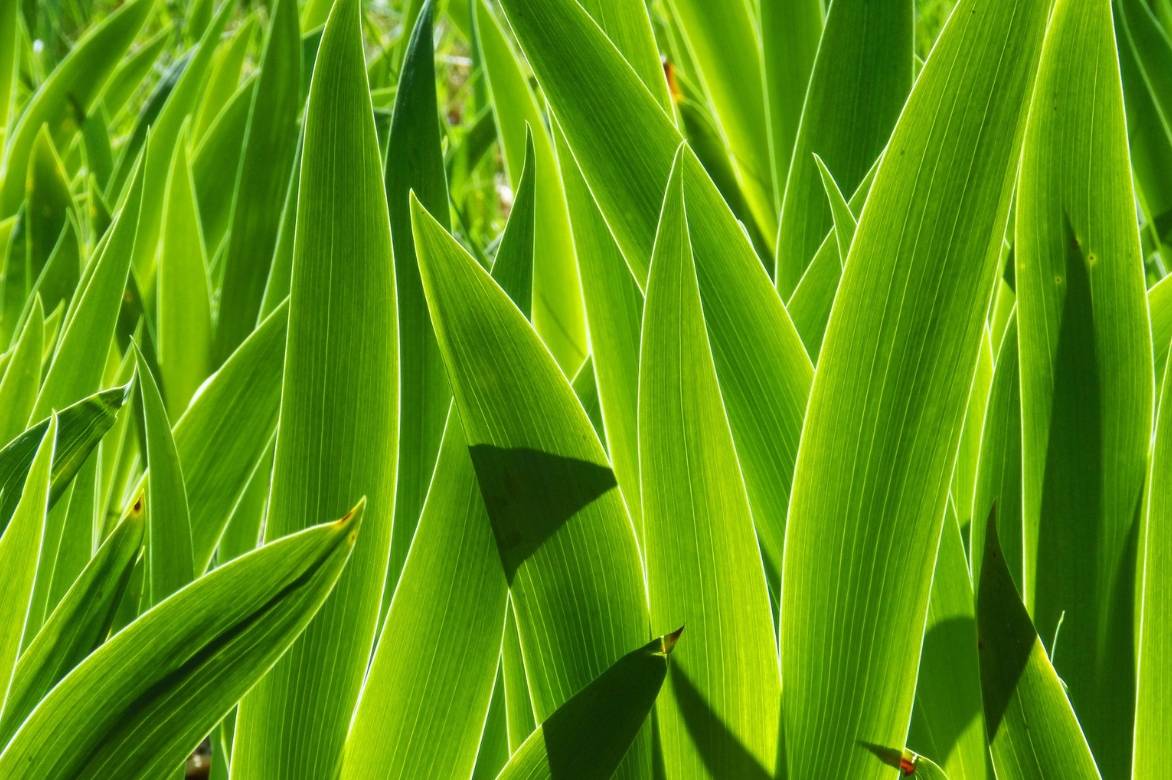 Beauty of Iris germanica foliage revealed under sun rays
Beauty of Iris germanica foliage revealed under sun rays
Read also
Iris germanica: how to propagate them?Main species and varieties
There are more than a thousand varieties of garden Iris, from the dwarf iris or Lilliput (under 40 cm) to the very tall bearded iris (up to 1 m). These thousands of cultivars are available in almost every colour, from pastel to garish, from plain to multicoloured.
They differ by their flowering period: early dwarf irises flower in April, tall irises in May–June. Alongside classic varieties, there are even perpetual irises capable of flowering several times a year, in mild climate and elsewhere when conditions are favourable.
The entire range can be used in beds, along driveways or in mixed borders. Early dwarf varieties are better suited to rockeries, containers and bed edges, tall irises will adorn the base of a wall or a sunny façade. Mid-sized irises are the most versatile.
Choose according to space available and size of surrounding plants from our unique collection of garden Iris, which includes many exclusive varieties!
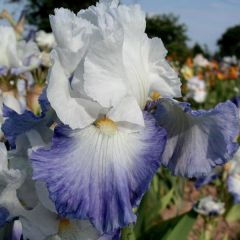
Iris germanica Alizes - Bearded Iris
- Flowering time June
- Height at maturity 85 cm
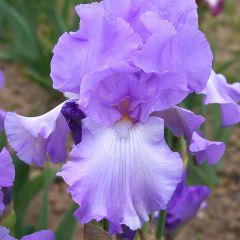
Iris germanica Mary Frances
- Flowering time June
- Height at maturity 95 cm
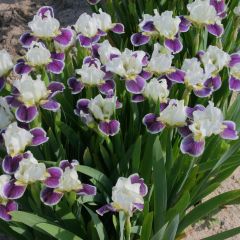
Iris germanica Making Eyes - Bearded Iris
- Flowering time May, June
- Height at maturity 35 cm
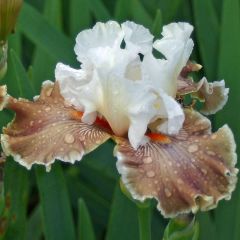
Iris germanica Coffee Whisper - Bearded Iris
- Flowering time June, July
- Height at maturity 95 cm
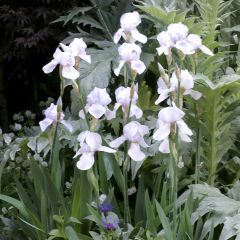
Iris germanica English Cottage - Bearded Iris
- Flowering time June
- Height at maturity 85 cm

Iris germanica Blue Crusader - Bearded Iris
- Flowering time June, July
- Height at maturity 1 m
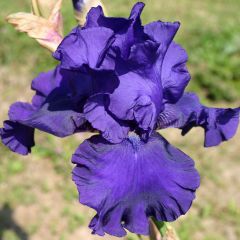
Iris germanica Blueberry Bliss - Bearded Iris
- Flowering time May, June
- Height at maturity 1 m
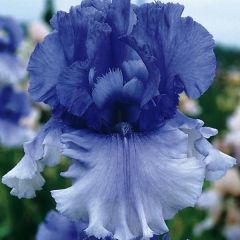
Iris germanica Cascade Springs - Bearded Iris
- Flowering time June to August
- Height at maturity 1 m
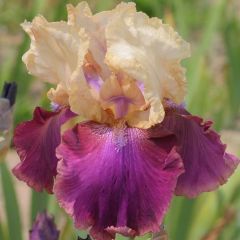
Iris germanica Jazz Festival
- Flowering time June, July
- Height at maturity 1 m
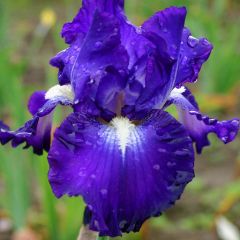
Iris Spot - Bearded Iris
- Flowering time July
- Height at maturity 1,10 m
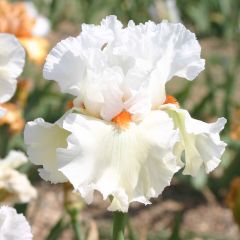
Iris germanica Lark Ascending - Bearded Iris
- Flowering time June
- Height at maturity 1,10 m
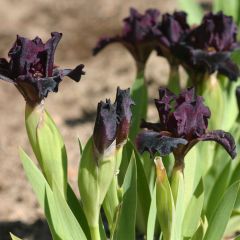
Iris germanica Devil Baby
- Flowering time May, June
- Height at maturity 20 cm
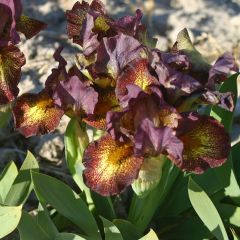
Iris germanica Firestorm - Bearded Iris
- Flowering time May, June
- Height at maturity 20 cm
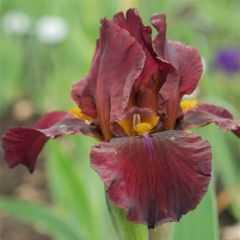
Iris Young Blood - Tall Bearded Iris
- Flowering time May, June
- Height at maturity 55 cm

Iris germanica Gracchus
- Flowering time June, November
- Height at maturity 70 cm
Discover other German Iris - Bearded Iris
View all →Available in 2 sizes
Available in 2 sizes
Available in 2 sizes
Available in 2 sizes
Available in 2 sizes
Available in 2 sizes
Available in 2 sizes
Available in 2 sizes
Available in 2 sizes
Available in 2 sizes
Planting Irises
Where to plant Iris germanica or garden iris?
Hardy, Iris germanica can be grown in all regions. They are not troubled by cold or summer drought.
Well established, they will reflower reliably for many years, fairly quickly forming pretty, colourful clumps. They like light and warmth.
A sunny, fairly dry site is ideal. While they tolerate partial shade, prefer full sun where they will be more floriferous: they need at least 6 hours’ sun per day.
They appreciate light, well-drained soils, even dry, stony and calcareous. Well suited to dry, hot summers, they are vulnerable to winter damp and dislike ground that is too wet, which favours rot of the rootstock.
In heavy soil, plant them on mounds, possibly on a slope.
They have vigorous growth: allow them space!
With their wide range of sizes, Iris germanica offer many uses for gardener. They will brighten bed and path edges, embankments or mixed borders, bringing elegance, colour and character. Some gardeners, seduced by this unique flowering, may create an iris bed or even an entire iris garden!
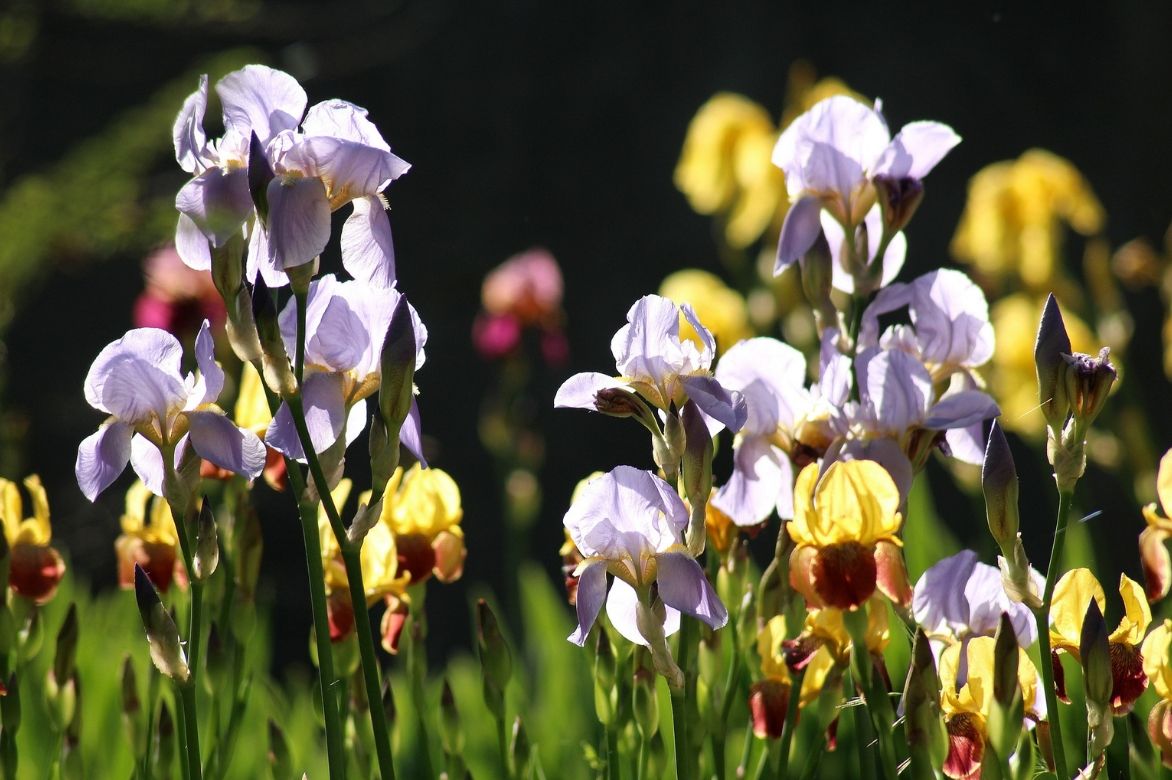
Exposed to strong wind, tall irises tend to flop if not staked: plant them at the base of a wall or a façade sheltered from wind.
A few clumps of iris will also enhance vegetable patch and provide cut flowers.
When to plant garden iris?
While planting garden iris can be done from early spring (February–March) through to September, best time to plant is summer after flowering, from July to September, when they are in full summer dormancy. They will root well before winter. Plant rootstocks as soon as received to avoid drying out or damage.
How to plant Iris germanica or bearded iris?
In open ground
Best effect is obtained by planting in small groups of several plants of same variety for a natural composition.
You can also favour a dramatic mass planting to create uniform iris beds: plant in staggered rows.
They need space to develop. Count about 5 to 7 plants per m² for tall irises, 10 plants per m² for intermediate sizes and around 15 per m² for dwarf irises. Space tall irises by about 30–50 cm. In 3 years a small iris reaches 30 cm wide, a large one double that.
Mixing varieties will allow spreading of flowering and produce around two and a half months of flowers in spring. Think of including perpetual varieties that reflower in late summer when conditions are favourable.
In heavy soil, lighten with some river sand and compost and preferably position rootstocks of Iris germanica above ground, possibly on a slight slope.
- Prepare soil to 30 cm depth
- Dig a wide, deep hole
- In heavy soil, place rootstocks on a small mound of earth you have formed to avoid any risk of rot, or plant them on a raised mound leaving rootstocks exposed
- Plant rootstocks barely covered and arranged like a star: leaves and buds turned outwards
- Cover with a thin layer of compost
- Water copiously to settle soil around roots
- Water 2 to 3 times per week until established
Discover more advice for planting iris in garden.
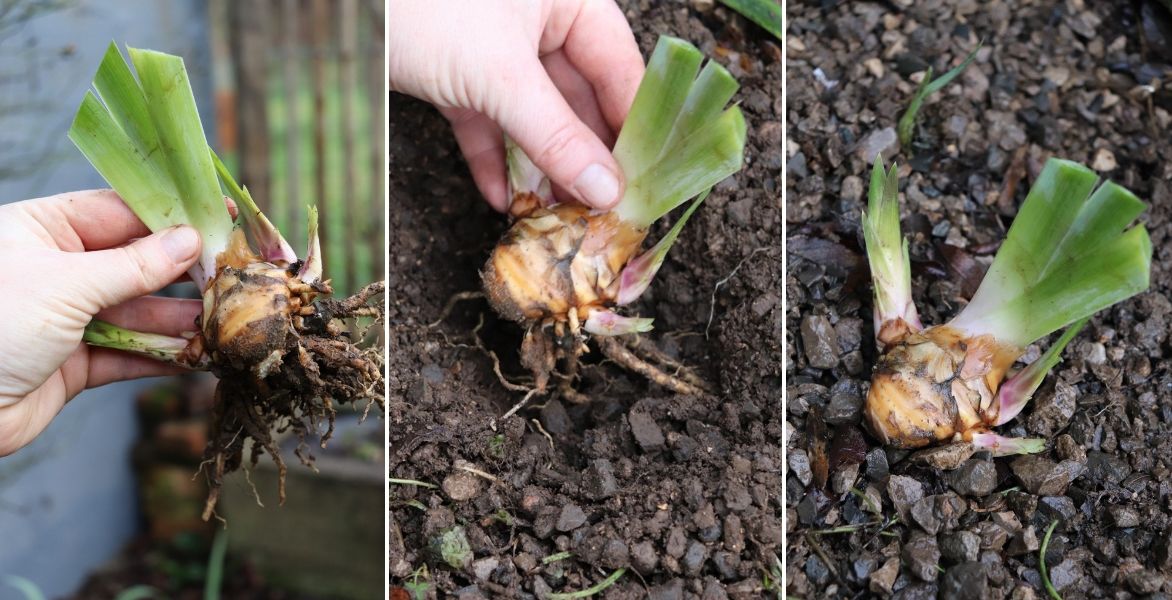
Planting a rootstock of Iris germanica
Planting garden iris in a pot
Iris germanica need plenty of space. For container planting, prefer dwarf irises; rootstocks of tall irises would not survive confined in a container.
- Spread a drainage layer of clay pebbles or gravel in bottom of pot or planter
- Plant at soil level, leaving rootstocks exposed at surface in a mix of well-rotted compost and potting compost
- Firm down and water
Read also
Iris germanica: how to plant them?Maintenance, pruning and care
Care is minimal. Bearded irises can remain in place and require little care. Water once a week during growth if soil is very dry, otherwise once every three weeks will suffice.
Weed regularly to keep rootstocks dry by shallow hoeing, taking care not to damage them: weeds retain moisture that can lead to root rot.
Bearded irises like rich soils: apply a fertiliser very low in nitrogen in early spring and again after flowering.
Cut faded flower stalks to 10 cm from ground after flowering
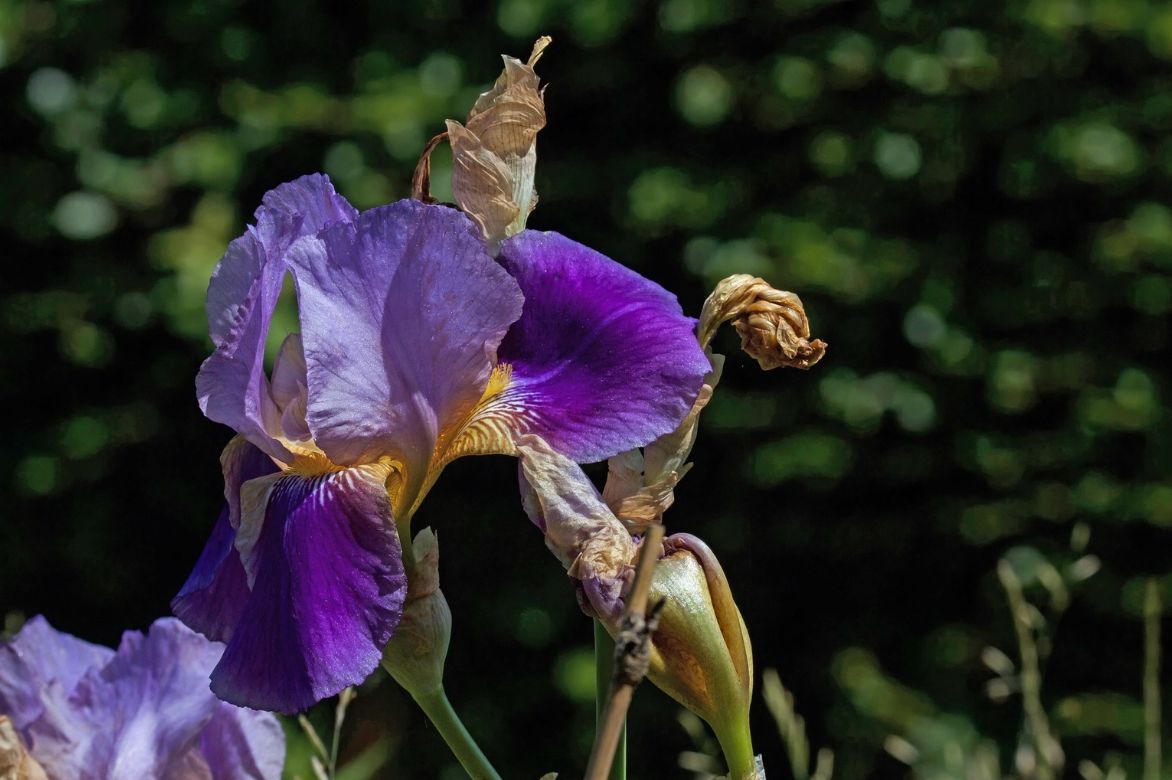
When the last flower has faded, cut the flower stalk to 10 cm from the ground
Do not cut leaves while they remain green; however, once fully dry, cut them with pruning shear.
Divide clumps of bearded irises every 3 to 6 years in August, because over time rootstocks become tangled and, when too crowded, become less floriferous.
Potential diseases and pests
Garden iris is vigorous but can nevertheless be prone to disease. It is particularly susceptible to moisture, responsible for the appearance of rot and the arrival of slugs. Keep beautiful irises in well-drained soil.
Remove dry leaves before they rot, as they can harbour heterosporosis, the most common disease of garden irises. This fungus eventually weakens the rootstock, leading in time to the death of the young plant. Diseased leaves first show reddish-edged spots then dry out: burn them. As a preventative measure from March to May, apply regular sprays of Bordeaux mixture.
In overly wet soil, rot is a real threat to rootstocks, which become soft, causing leaves to yellow. Entire plant then gives off a foul smell of rot. If affected: remove all diseased parts down to healthy tissue.
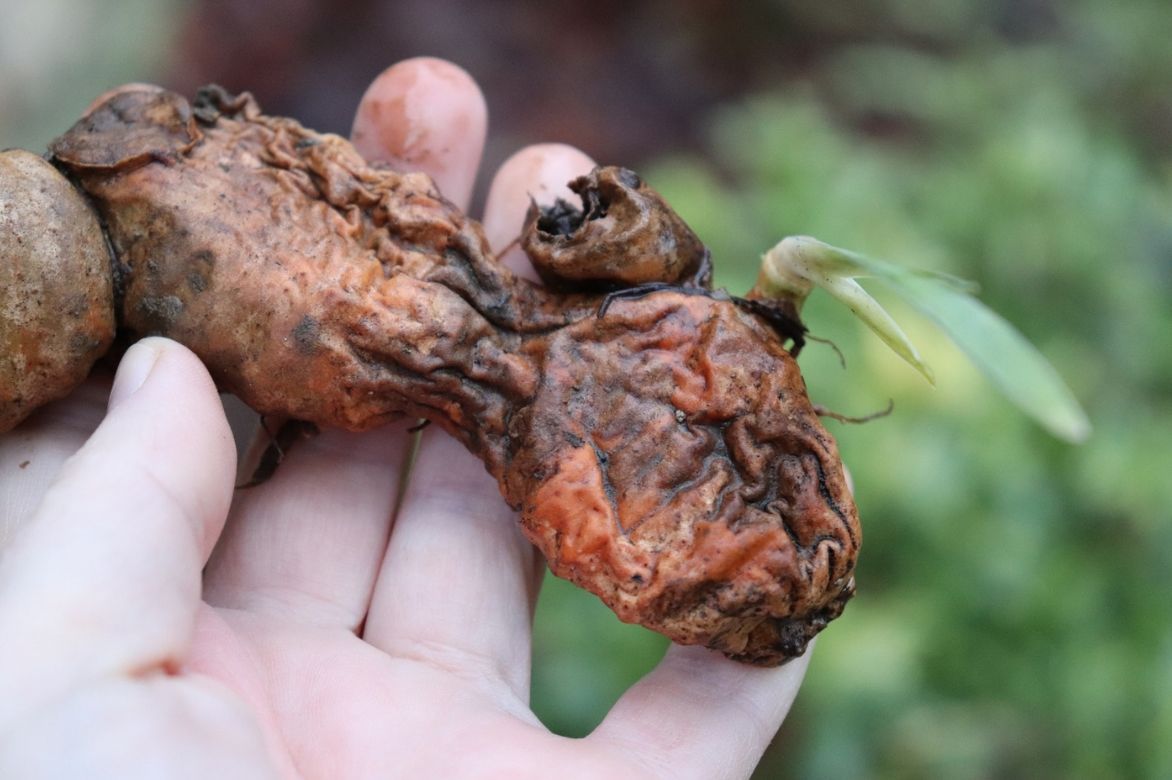
In overly wet soil, rootstocks become soft and eventually rot… remove these diseased parts!
Slugs and snails love young foliage: discover our solutions to deter them.
Mosaic is a viral disease that causes general stunting of the iris, the appearance of mottling on petals and yellowish striate streaks on the leaves. Destroy infected young plants as there is no treatment.
Discover even more tips to protect them from disease!
Multiplication
Bearded iris is easily propagated by division of rootstocks. Division of iris stumps also helps rejuvenate clumps. Carry out every 3 or 4 years, from July to October.
- Water a few days beforehand to make lifting easier
- Lift out the stump using a garden fork, levering it out
- Remove dry leaves and weeds from the centre of the clump
- Lift the rootball with a garden fork
- Remove soil and weeds
- With a sharp, well-disinfected knife to avoid any risk of rot, separate the rootstocks at the periphery of the clump
- Select the largest and cut at the base
- Reduce foliage by half before replanting the rootstock immediately just at soil level, in full sun in well-prepared, enriched soil
- Water well after planting
Companion planting: what to plant with garden irises?
With its beautiful stylised flowers, Bearded iris is essential in a romantic garden or a cottage garden to create poetic, elegant and colourful scenes. It is also one of the great classics of mixed borders, from which it emerges with flair! It commands a place in all classic beds or even in contemporary gardens.
It is used in contrasting combinations or in monochrome schemes in borders.
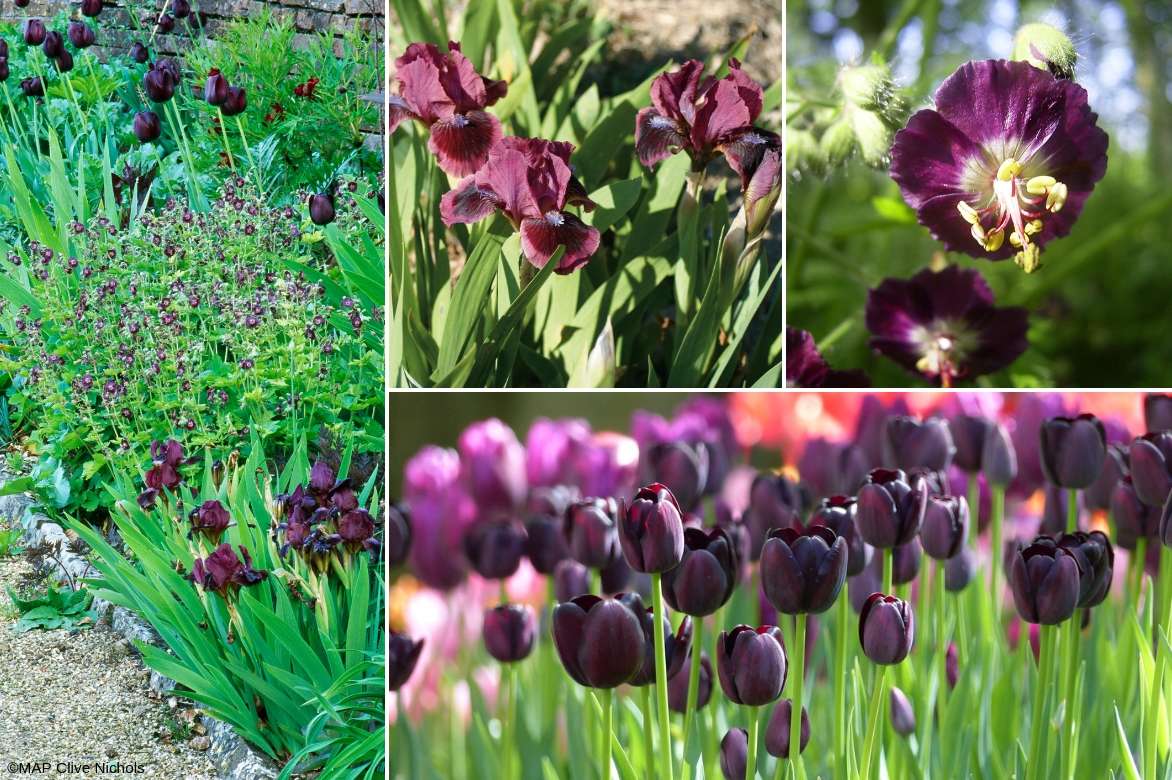
An example of a monochrome combination: Iris germanica ‘Cat’s Eye’, Geranium phaeum, Tulips ‘Queen of Night’ to which you can add Tulips ‘Black Parrot’
Mixing varieties of bearded iris together will help stagger flowering periods.
Pair with low-growing plants as it copes poorly with competition.
In a colourful mixed border, bearded irises make fine combinations with old roses and Allium, lupins, peonies or foxgloves.
Eschscholzia, salvias and Libertia also complement Iris germanica very well.
Tall irises make a striking display when surrounded by plants with softer outlines such as Thalictrum, gaura, Nigella damascena, Achillea millefolium and stipa.
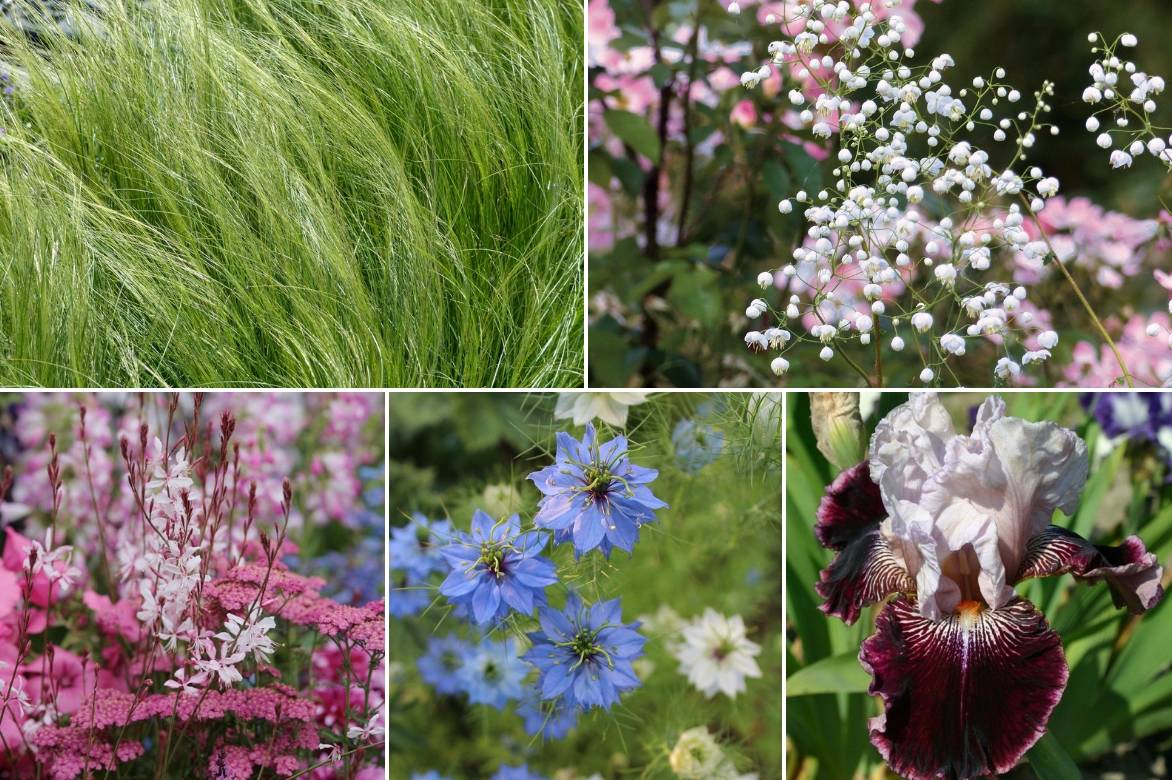
Another example of a combination: Stipa tenuifolia, Thalictrum delavayii ‘Splendide Album’, Achillea millefolium ‘Pretty Belinda’ (similar varieties: ‘Saucy Seduction’ or ‘Apfelblute’) and Gaura ‘Summer Emotion’ (similar varieties: ‘Rosy Jane’ or ‘Cherry Brandy’), Nigella, Iris germanica ‘Amethyst Dancer’
In borders and rockeries, dwarf varieties are enhanced by stachys and hardy geraniums, nepetas.
To flower the base of a well-exposed wall, plant with valerians and Byzantine gladioli which will take over flowering.
Mediterranean plants such as cistus, Phlomis and santolinas also make good companions.
Useful resources
- Discover national iris collections at Parc Floral de la Source in Orléans!
- From Iris germanica to Japanese iris, via Siberian iris, discover our unique collection of irises
- Create a romantic flower bed with our garden irises!
- What to plant in dry soil to accompany your Iris germanica?
- Purple and anise, All black, or white, pink, purple inspiration, all combinations are possible with garden irises!
- Iris germanica: 6 ideas for successful pairings!
- Perfumers’ plants
- Iris – unmissable summer 2022 new releases! and Iris: our 2023 new releases and Iris: our 2024 new releases
- Subscribe!
- Contents

































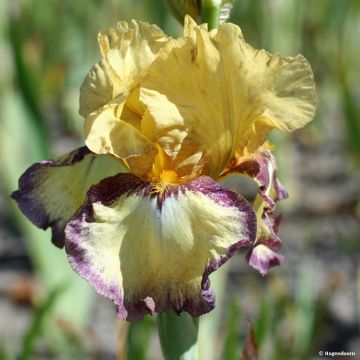
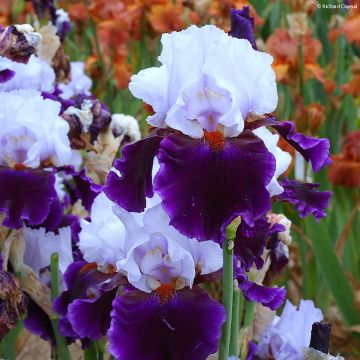
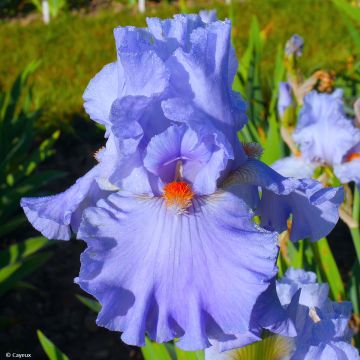
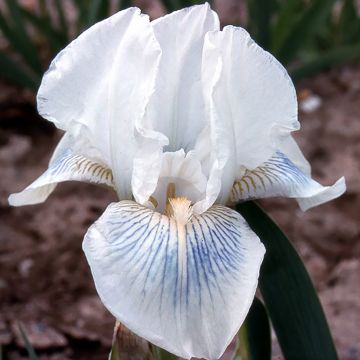

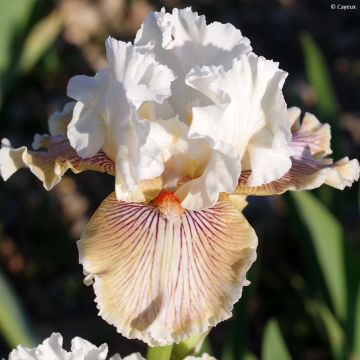


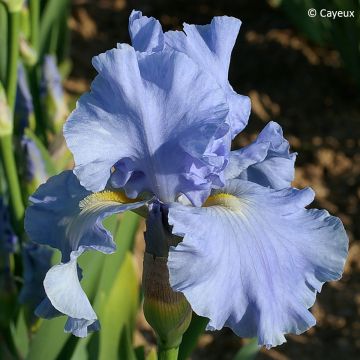
Comments